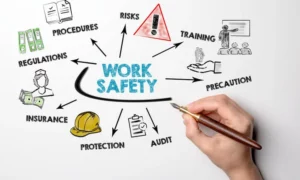Introduction:
Emergency evacuation diagrams are a crucial aspect of workplace safety in Australia. They provide a detailed visual guide to the most effective evacuation routes in case of an emergency or fire. In this guide, we will discuss the importance of emergency evacuation diagrams, who needs them, and what they should contain. We will also cover what you can do to ensure your safety during an emergency or fire at work. Ensure that no one is hurt in the case of a fire by being prepared.
What are emergency evacuation diagrams, and what do they show?
Emergency evacuation diagrams are visual guides that provide information about the safest and most efficient exits from a building in an emergency. They show the building layout and the routes that need to be taken to evacuate the building safely. These diagrams use different symbols to represent doors, windows, stairwells, elevators, and other emergency equipment. Everyone in the building should be aware of where the evacuation diagram is located and be familiar with how to exit in case of an emergency safely.
Who should have an emergency evacuation diagram?
Emergency evacuation diagrams are vital for any building that could potentially have hazardous situations in an emergency. All personnel in these buildings must be aware of the evacuation plan. Hospitals, schools, colleges, aged care facilities, engineering workplaces, factories, process plants, manufacturing workspaces, child care centres, restaurants, and sporting clubs should all have evacuation diagrams on-site. However, only some can create an emergency evacuation diagram, which leads to the next important factor, the requirements.
Are there any specific requirements for emergency evacuation diagrams in Australia?
Evacuation diagrams in Australia must comply with the prescribed requirements of AS 3745-2010. They must clearly display a pictorial representation of the floor or area with a title that reads either “Evacuation Diagram” or “Fire Evacuation Plan” in QLD. Exits should be marked in green, and firefighting equipment should be present. The validity date and location of assembly points must also be included, along with a legend to explain any evacuation diagram symbols used.
Optional information for evacuation diagrams
Comprehensive fire safety information should be included on your fire diagrams, although these are optional. This includes:
- north indicators
- the direction of emergency door openings
- electrical switchboards should be specified
- first aid kits
- defibrillators
- spill response kits
- and fire hydrants should also be included for optimal safety.
The details should align with the organisation’s evacuation plan for seamless implementation of its emergency policies.
What should you do if there is an emergency and you need to evacuate your building or property in Australia?
In case of an emergency requiring the evacuation of a building or property in Australia, it is crucial to follow instructions and advice from relevant authorities on the scene, and some businesses may have a trained fire warden whom you should follow in the event of a fire. Generally, follow these rules: remain calm, stay informed, listen carefully, and act fast to ensure safety and efficiency. It is recommended that individuals become familiar with safety resources available in their communities before an emergency occurs to prepare ahead of time.
How can you ensure that you are safe during a fire or other emergency situation at work?
Being prepared for an emergency situation while at work can help keep you safe. Familiarise yourself with fire safety and evacuation policies within the workplace, as it may be necessary to execute those protocols during an emergency. Create a plan of action, including designating a safe meeting spot outside the building and assigning specific roles to people if the staff is evacuated. These preemptive steps will give you more confidence in handling emergent situations at work.
Conclusion:
Emergency evacuation diagrams are critical in providing clear and concise information on how to evacuate a building in case of an emergency. All buildings or properties should have evacuation diagrams, and they should comply with Australia’s specific requirements. If there is an emergency situation at your workplace or elsewhere, follow the instructions on your emergency evacuation diagram to evacuate safely and quickly. Be prepared for emergencies by familiarising yourself with the workplace’s safety policies and creating a plan of action. Get your emergency evacuation diagrams today to be prepared for any emergency tomorrow.



































